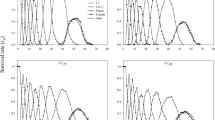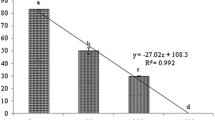Abstract
The antibiotic effects of 3 phenolic substances viz. resorcinol, gallic acid and phloroglucinol on the cotton bollwormHeliothis armigera Hubner were evaluated with particular reference to the feeding regimes, survival and pupation. Some of the characteristic antibiotic effects observed for resorcinol and phloroglucinol include reduction in consumption index and approximate digestability, increased efficiency of conversion of ingested food and efficiency of conversion of digested food, extended larval duration and high mortality. However, there was no alteration in the various food utilization efficiencies in the case of gallic acid treated individuals. The defensive response of the larvae to these toxic substances seems to be excessive defaecation. Frass analysis through thin-layer chromatography and ultraviolet characterisation indicated the presence of the ingested antibiotics, opening further avenues of investigation on the possible role of these antibiotics present in the frass in biological control.
Similar content being viewed by others
References
Annadurai R S, Murugesan S and Senrayan R 1989 Age correlated host-tissue preferences ofHeliotkis armigera (Hubner) andSpodoptera litura (F.) with special reference to phenolic components; (in press)
Beck S D 1956 The European corn borer,Pyrausta nubilalis (Hubner) and its principal host plant. II. The influence of nutritional factors on larval establishment and development on the corn plant;Ann. Entomol. Soc. Am. 49 582–588
Beck S D 1957 The European corn borer,Pyrausta nubilalis (Hubn), and its principal host plant. VI. Host plant resistance to larval establishment;J. Insect Physiol. 1 158–177
Beck S D 1960 The European corn borer,Pyrausta nubilalis (Hubner) and its principal host plant. VII. Larval feeding behaviour and host plant resistance;Ann. Entomoi Soc. Am. 53 206–212
Beck S D 1965 Resistance of plants to insects;Annu. Rev. Entomol. 10 207–232
Beck S D and Reese J C 1976 Insect-plant interactions: Nutrition and Metabolism;Rec. Adv. Phytochem. 10 41–92
Beck S D and Stauffer J F 1957 The European corn borer,Pyrausta nubilalis (Hubner) and its principal host plant. III. Toxic factors influencing larval establishment;Ann. Entomoi. Soc. Am. 50 166–170
Bell A A 1974 Biochemical bases of resistance of plants to pathogens; inProc. Summer Institute on Biological control of plant insects and diseases (eds) F G Maxwell and F A Harris (Jackson: University press of Missisippi) pp 403–463
Bernays E A 1978 Tannins: An alternative viewpoint;Entomoi. Exp. Appl. 24 44–53
Bottger G T and Patana R 1966 Growth, development and survival of certain lepidoptera fed gossypol in the diet;J. Econ. Entomol. 59 1166–1168
Callahan P S 1962 Techniques for rearing the corn earworm,Heliothis armigera;J. Econ. Entomol. 55 453–457
Chan B G, Waiss J R A C, Binder R G and Elliger C A 1978 Inhibition of lepidopterous larval growth by cotton constituents;Entomoi Exp. Appl. 24 94–100
Chapman R F 1974 The chemical inhibition of feeding by phytophagous insects: a review;Bull. Entomol. Res. 64 339–363
Dethier V G 1970 Chemical interactions between plants and insects; inChemical ecology (eds) E Sondheimer and J B Simeone (New York: Academic Press) pp 83–102
Doby G 1965Plant biochemistry (New York: Interscience Publishers)
Erickson J M and Feeny P 1974 Sinigrin: a chemical barrier to the black swallowtail butterfly,Papilio polyxenes;Ecology 55 103–111
Feeny P 1968 Effect of oak leaf tannins on larval growth of the winter moth,Operaphthera brumata;J. Insect Physiol. 14 805–817
Feeny P 1976 Plant apparency and chemical defense;Rev. Adv. Phytochem. 10 1–40
Fraenkel G 1969 Evaluation of our thought on secondary plant substances;Entomol. Exp. Appl. 12 473–486
Gallun R L, Starks K J and Guthrie W D 1975 Plant resistance to insects attacking cereals;Annu. Rev. Entomol. 20 75–95
Goldstein J L and Swain T 1965 The inhibition of enzymes by tannins;Phytochemistry 4 185–192
Hanover J W 1975 Physiology of tree resistance to insects;Annu. Rev. Entomol. 20 75–95
Harborne J B and Williams C A 1969 The identification of Orcinol in higher plants in the family Ericaceae;Phytochemistry 8 2223
Harley K L S and Thorsteinson A J 1967 The influence of plant chemicals on the feeding behaviour, development and survival of the two-striped grasshopper,Melanoplus bivittatus (Say), (Acrididae: Orthoptera);Can. J. Zool. 45 305–319
Kamikado T, Chang C F, Murakoshi S, Akira S A and Tamura S 1975 Isolation and structure elucidation of growth inhibitors on silkworm larvae from Magnolia kobus DC;Agric. Biol. Chem. 39 833–836
Kato M 1978 Phenols as indispensible components of the synthetic diet of the silkworm,Bombyx mori;Entomol. Exp. Appl. 24 285–290
Kogan M 1975 Plant resistance in pest management; inIntroduction to insect pest management; (eds) R L Metcalf and W Luckmann (New York: John Wiley) pp 103–146
Luckey T D 1968 Insecticide hormologesis;J. Econ. Entomol. 61 7–12
Lukefahr M J, Cowan C B, Pfrimmer T R and Noble L W 1965 Resistance of experimental cotton strain 1514 to the bollworm and cotton flea hopper;J. Econ. Entomol. 59 393–395
Lukefahr M J, Houghtaling J E and Graham H M 1971 Suppression ofHeliothis populations with glabrous cotton strains;J. Econ. Entomol. 64 486–488
Lukefahr M J and Martin D F 1966 Cotton plant pigments as a source of resistance to the bollworm and tobacco budworm;J. Econ. Entomol. 59 176–179
Matsumato Y 1962 A dual effect of coumarin, olfactory attraction and feeding inhibition, on the vegetable weevil adult, in relation to the uneatability of sweet clover leaves. Studies on host plant discrimination of the leaf-feeding insects, VI;J. Appl. EntomoL Zool. 6 141–149
Maxwell F G, Jenkins J N and Parrot W L 1972 Resistance of plants to insects;Adv. Agron. 24 187–265
Onslow M N 1923Practical plant biochemistry (Cambridge: Cambridge University Press)
Pathak M D and Dale D 1983 The biochemical basis of resistance in host plants to insect pests; inChemistry and world food supplied: The frontiers, Chemrawan II (ed.) L W Shemilt (Oxford, New York: Pergamon Press) pp 273
Reese J C and Beck S D 1976a Effects of allelochemics on the black cutworm,Agrotis ipsilon: Effects ofp-Benzoquinone, Hydroquinone and Duroquinone on larval growth, development and utilization of food;Ann. Entomol. Soc. Am. 69 59–67
Reese J C and Beck S D 1976b. Effects of allelochemics on the black cutworm,Agrotis ipsilon; Effects of catechol, L. Dopa, Dopamine, and chlorogenic acid on larval growth, development and utilization of food;Ann. Entomol. Soc. Am. 69 68–72
Reese J C and Beck S D 1976c Effects of allelochemics on the black cutworm,Agrotis ipsilon: Effects of resorcinol, phloroglucinol and gallic acid on larval growth, development and utilization of food;Ann. Entomol. Soc. Am. 69 999–1003
Reese J C and Carlson S D 1974 Scanning electron microscopy of final instar larval mouthparts of the black cutworm,Agrotis ipsilon;Ann. Entomol. Soc. Am. 67 301–308
Robinson T 1963The organic constituents of higher plants (Minneapolis: Burgers Publishing Co.)
Schoonhoven L M 1972 Secondary plant substances and insects;Rec. Adv. Phytochem. 5 197–224
Self L S, Guthrie F E and Hodgson E 1964 Adaptation of tobacco hornworms to the ingestion of nicotine;J. Insect Physiol. 10 907–914
Shaver T N, Lukefahr M J and Garcia J A 1970 Food utilization ingestion, and growth of larvae of the bollworm and tobacco budworm on diets containing gossypol;J. Econ. Entomol. 63 1544–1546
Singh P 1971Artificial diets for insects, mites and spiders (New York: Plenum)
Soo Hoo C F and Fraenkel G 1966 The consumption, digestion and utilization of food plants by a polyphagous insect,Prodenia eridania (Cramer);J. Insect. Physiol. 12 711–730
Todd G W, Getahun A and Cress D C 1971 Resistance in barley to the greenbug,Schizophis graminum. I. Toxicity of phenolic and flavonoid compounds and related substances;Ann. Entomol. Soc. Am. 64 718–722
Waiss A C Jr, Chan B G, Elliger C A, Wiseman B R, Mcmillian W W, Widstrom N W, Zuber M S and Keaster A J 1979 Maysin, a flavone glyioside from corn silk with antibiotic activity toward corn earworm;J. Econ. Entomol. 72 256–258
Waldbauer G P 1964 The consumption, digestion and utilization of solanaceous and non-solanaceous plants by larvae of the tobacco hornworm,Protoparce sexta (Johan) (Lepidoptera: Sphingidae);Entomol. Exp. Appl. 7 253–269
Waldbauer G P 1968 The consumption and utilization of food by insects;Adv. Insect. Physiol. 5 229–269
Whittaker R H 1970 The biochemical ecology of higher plants; inChemical ecology (eds) E Sondheimer and J B Simeone (New York: Academic Press) pp 43–70
Williams W G, Kennedy G G, Yamamoto R T, Thacker J D and Bordner J 1980 2-Tridecanone: A naturally occuring insecticide from the wild tomatoLycopersicon hirsutum f.glabratum;Science 207 888–889
Wiseman B R, Widstrom N W, Mcmillian W W and Perkins W D 1976 Greenhouse evaluations of leaffeeding resistance in corn to corn earworm (Lep. Noct);J. Ga. Entomol. Soc. 11 63–37
Wong E 1973 Plant phenolics; inChemistry and biochemistry of herbage (eds) G W Butler and R W Bailey (New York: Academic Press) pp 265–322
Author information
Authors and Affiliations
Rights and permissions
About this article
Cite this article
Ananthakrishnan, T.N., Senrayan, R., Annadurai, R.S. et al. Antibiotic effects of resorcinol, gallic acid and phloroglucinol onHeliothis armigera Hubner (Insecta: Noctuidae). Proc Ani Sci 99, 39–52 (1990). https://doi.org/10.1007/BF03186371
Received:
Issue Date:
DOI: https://doi.org/10.1007/BF03186371




